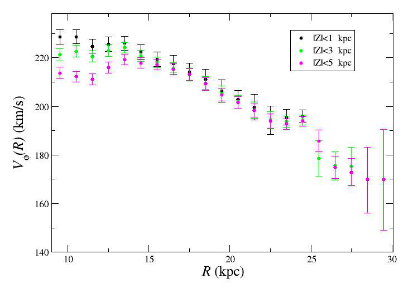I just want to see all this as a 3-D map that I can zoom into and pan and tilt.
And play forward and backward tens of millions of years.
https://arxiv.org/pdf/2211.05668.pdf
Mapping the Milky Way Disk with GAIA DR3: 3D extended kinematic maps and rotation curve to ≈ 30 kpc
The Gaia mission (Gaia Collaboration et al. 2016) is
providing the most detailed Milky Way survey to date
by measuring stellar astrometry, photometry, and spec-
troscopy. From this data-set it is possible to derive the
spatial distribution, kinematics, and many other phys-
ical properties of the Milky Way. The third Gaia data
release (DR3) (Gaia Collaboration et al. 2022a) contains
a wider sample of stars with new determinations
of spectra, radial velocity, chemical abundance, value-
added catalogs, etc.
DR3 has also provided a significant increase of the stars
line-of-sight velocity catalog, from 7,209,831 in DR2 to
33,812,183 in DR3

Azimuthal velocity as function of distance from the centre of the Milky Way.

The two determinations of the Galaxy rotation curve
by Mr ́oz et al. (2019); Eilers et al. (2019) and the one
presented in this work (that up to 20 kpc coincides with
the one by L ́opez-Corredoira & Sylos Labini (2019))
are different from others reported in the literature
(see, e.g. Bhattacharjee et al. (2014); Sofue (2020))
where the rotation curve of the Milky Way did not
present a decrease in the range of distances between
15 kpc and 30 kpc.
This has a BIG influence on the calculation of the dark matter distribution in the Milky Way. A uniform dark matter halo would give a lack of decrease in rotation curve between 15 and 30 kpc radius. So this tells us that the density of dark matter in the halo is decreasing with radius even this close to the centre of the Milky Way.